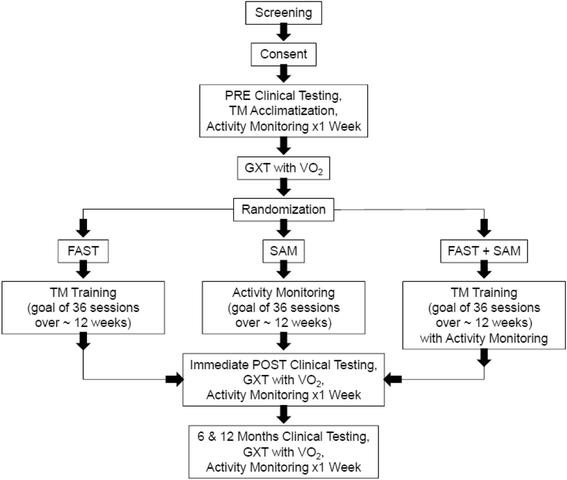Protocol for promoting recovery optimization of walking activity in stroke (PROWALKS): a randomized controlled trial
- PMID: 29649992
- PMCID: PMC5898044
- DOI: 10.1186/s12883-018-1044-1
Protocol for promoting recovery optimization of walking activity in stroke (PROWALKS): a randomized controlled trial
Abstract
Background: Stroke survivors are more physically inactive than even the most sedentary older adults, and low activity is associated with increased risk of recurrent stroke, medical complications, and mortality. We hypothesize that the combination of a fast walking intervention that improves walking capacity, with a step activity monitoring program that facilitates translation of gains from the clinic to the "real-world", would generate greater improvements in real world walking activity than with either intervention alone.
Methods: Using a single-blind randomized controlled experimental design, 225 chronic (> 6 months) stroke survivors complete 12 weeks of fast walking training, a step activity monitoring program or a fast walking training + step activity monitoring program. Main eligibility criteria include: chronic ischemic or hemorrhagic stroke (> 6 months post), no evidence of cerebellar stroke, baseline walking speed between 0.3 m/s and 1.0 m/s, and baseline average steps / day < 8000. The primary (steps per day), secondary (self-selected and fastest walking speed, walking endurance, oxygen consumption) and exploratory (vascular events, blood lipids, glucose, blood pressure) outcomes are assessed prior to initiating treatment, after the last treatment and at a 6 and 12-month follow-up. Moderation of the changes in outcomes by baseline characteristics are evaluated to determine for whom the interventions are effective.
Discussion: Following completion of this study, we will not only understand the efficacy of the interventions and the individuals for which they are effective, we will have the necessary information to design a study investigating the secondary prevention benefits of improved physical activity post-stroke. This study is, therefore, an important step in the development of both rehabilitative and secondary prevention guidelines for persons with stroke.
Trial registration: ClinicalTrials.gov Identifier: NCT02835313 . First Posted: July 18, 2016.
Keywords: Physical activity; Rehabilitation; Stroke; Walking.
Conflict of interest statement
Ethics approval and consent to participate
This research has been approved by the University of Delaware, Christiana Care Health System and University of Pennsylvania Institutional Review Boards.
Consent for publication
Not applicable – this manuscript does not contain an individual person’s data.
Competing interests
The authors declare that they have no competing interests.
Publisher’s Note
Springer Nature remains neutral with regard to jurisdictional claims in published maps and institutional affiliations.
Figures
References
Publication types
MeSH terms
Associated data
Grants and funding
LinkOut - more resources
Full Text Sources
Other Literature Sources
Medical


